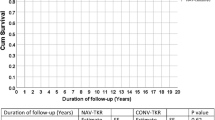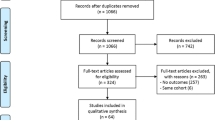Abstract
Background
Total knee replacements (TKR) aim to restore stability of the tibiofemoral and patella-femoral joints and provide relief of pain and improved quality of life for the patient. In recent years, computer-assisted navigation systems have been developed with the aim of reducing human error in joint alignment and improving patient outcomes.
Methods
We examined the current body of evidence surrounding the use of navigation systems and discussed their current and future role in TKR.
Results
The current body of evidence shows that the use of computer navigation systems for TKR significantly reduces outliers in the mechanical axis and coronal prosthetic position. Also, navigation systems offer an objective assessment of soft tissue balancing that had previously not been available. Although these benefits represent a technical superiority to conventional TKR techniques, there is limited evidence to show long-term clinical benefit with the use of navigation systems, with only a small number of studies showing improvement in outcome scores at short-term follow-up. Because of the increased costs and operative time associated with their use as well as the emergence of more affordable and patient-specific technologies, it is unlikely for navigation systems to become more widely used in the near future.
Conclusions
Whilst this technology helps surgeons to achieve improved component positioning, it is important to consider the clinical and functional implications, as well as the added costs and potential learning curve associated with adopting new technology.

Similar content being viewed by others
References
Insall JN, Binazzi R, Soudry M, Mestriner LA (1985) Total knee arthroplasty. Clin Orthop Relat Res 192:13–22
Insall J, Tria AJ, Scott WN (1979) The total condylar knee prosthesis: the first 5 years. Clin Orthop Relat Res (145):68-77
Dorr LD, Boiardo RA (1986) Technical considerations in total knee arthroplasty. Clin Orthop Relat Res 205:5–11
Miyasaka T, Kurosaka D, Saito M, Omori T, Ikeda R, Marumo K (2017) Accuracy of computed tomography-based navigation-assisted total knee arthroplasty: outlier analysis. J Arthroplasty 32(1):47–52
Hiscox CM, Bohm ER, Turgeon TR, Hedden DR, Burnell CD (2011) Randomized trial of computer-assisted knee arthroplasty: impact on clinical and radiographic outcomes. J Arthroplasty 26(8):1259–1264
Kim YH, Kim JS, Choi Y, Kwon OR (2009) Computer-assisted surgical navigation does not improve the alignment and orientation of the components in total knee arthroplasty. J Bone Joint Surg Am 91(1):14–19
Kim YH, Kim JS, Yoon SH (2007) Alignment and orientation of the components in total knee replacement with and without navigation support: a prospective, randomised study. J Bone Joint Surg Br 89(4):471–476
Lutzner J, Krummenauer F, Wolf C, Gunther KP, Kirschner S (2008) Computer-assisted and conventional total knee replacement: a comparative, prospective, randomised study with radiological and CT evaluation. J Bone Joint Surg Br 90(8):1039–1044
Stulberg SD, Yaffe MA, Koo SS (2006) Computer-assisted surgery versus manual total knee arthroplasty: a case-controlled study. J Bone Joint Surg Am 88(Suppl 4):47–54
Bauwens K, Matthes G, Wich M et al (2007) Navigated total knee replacement: a meta-analysis. J Bone Joint Surg Am 89(2):261–269
Mason JB, Fehring TK, Estok R, Banel D, Fahrbach K (2007) Meta-analysis of alignment outcomes in computer-assisted total knee arthroplasty surgery. J Arthroplast 22(8):1097–1106
Brin YS, Nikolaou VS, Joseph L, Zukor DJ, Antoniou J (2011) Imageless computer assisted versus conventional total knee replacement. A Bayesian meta-analysis of 23 comparative studies. Int Orthop 35(3):331–339
Hetaimish BM, Khan MM, Simunovic N, Al-Harbi HH, Bhandari M, Zalzal PK (2012) Meta-analysis of navigation vs conventional total knee arthroplasty. J Arthroplast 27(6):1177–1182
Cheng T, Zhao S, Peng X, Zhang X (2012) Does computer-assisted surgery improve postoperative leg alignment and implant positioning following total knee arthroplasty? A meta-analysis of randomized controlled trials? Knee Surg Sports Traumatol Arthrosc 20(7):1307–1322
Fu Y, Wang M, Liu Y, Fu Q (2012) Alignment outcomes in navigated total knee arthroplasty: a meta-analysis. Knee Surg Sports Traumatol Arthrosc 20(6):1075–1082
Minoda Y, Kobayashi A, Iwaki H et al (2010) The risk of notching the anterior femoral cortex with the use of navigation systems in total knee arthroplasty. Knee Surg Sports Traumatol Arthrosc 18(6):718–722
Chung BJ, Kang YG, Chang CB, Kim SJ, Kim TK (2009) Differences between sagittal femoral mechanical and distal reference axes should be considered in navigated TKA. Clin Orthop Relat Res 467(9):2403–2413
Chauhan SK, Scott RG, Breidahl W, Beaver RJ (2004) Computer-assisted knee arthroplasty versus a conventional jig-based technique. A randomised, prospective trial. J Bone Joit Surg Br 86(3):372–377
Czurda T, Fennema P, Baumgartner M, Ritschl P (2010) The association between component malalignment and post-operative pain following navigation-assisted total knee arthroplasty: results of a cohort/nested case-control study. Knee Surg Sports Traumatol Arthrosc 18(7):863–869
Ishida K, Matsumoto T, Tsumura N et al (2011) Mid-term outcomes of computer-assisted total knee arthroplasty. Knee Surg Sports Traumatol Arthrosc 19(7):1107–1112
Matziolis G, Krocker D, Weiss U, Tohtz S, Perka C (2007) A prospective, randomized study of computer-assisted and conventional total knee arthroplasty: three-dimensional evaluation of implant alignment and rotation. J Bone Joint Surg Am 89(2):236–243
Oberst M, Bertsch C, Wurstlin S, Holz U (2003) CT analysis of leg alignment after conventional vs. navigated knee prosthesis implantation. Initial results of a controlled, prospective and randomized study. Unfallchirurg 106(11):941–948
Restrepo C, Hozack WJ, Orozco F, Parvizi J (2008) Accuracy of femoral rotational alignment in total knee arthroplasty using computer assisted navigation. Comput Aided Surg 13(3):167–172
Schmitt J, Hauk C, Kienapfel H et al (2011) Navigation of total knee arthroplasty: rotation of components and clinical results in a prospectively randomized study. BMC Musculoskelet Disord 12:16
Stockl B, Nogler M, Rosiek R, Fischer M, Krismer M, Kessler O (2004) Navigation improves accuracy of rotational alignment in total knee arthroplasty. Clin Orthop Relat Res 426:180–186
van der Linden-van der Zwaag HM, Bos J, van der Heide HJ, Nelissen RG (2011) A computed tomography based study on rotational alignment accuracy of the femoral component in total knee arthroplasty using computer-assisted orthopaedic surgery. Int Orthop 35(6):845–850
Zorman D, Etuin P, Jennart H, Scipioni D, Devos S (2005) Computer-assisted total knee arthroplasty: comparative results in a preliminary series of 72 cases. Acta Orthop Belg 71(6):696–702
Burnett RS, Barrack RL (2013) Computer-assisted total knee arthroplasty is currently of no proven clinical benefit: a systematic review. Clin Orthop Relat Res 471(1):264–276
Hoffart HE, Langenstein E, Vasak N (2012) A prospective study comparing the functional outcome of computer-assisted and conventional total knee replacement. J Bone Joint Surg Br 94(2):194–199
Pang HN, Yeo SJ, Chong HC, Chin PL, Ong J, Lo NN (2011) Computer-assisted gap balancing technique improves outcome in total knee arthroplasty, compared with conventional measured resection technique. Knee Surg Sports Traumatol Arthrosc 19(9):1496–1503
Johnson DR, Dennis DA, Kindsfater KA, Kim RH (2013) Evaluation of total knee arthroplasty performed with and without computer navigation: a bilateral total knee arthroplasty study. J Arthroplast 28(3):455–458
Saragaglia D, Sigwalt L, Gaillot J, Morin V, Rubens-Duval B, Pailhé R (2017) Results with eight and a half years average follow-up on two hundred and eight e-Motion FP® knee prostheses, fitted using computer navigation for knee osteoarthritis in patients with over ten degrees genu varum. Int Orthop
de Steiger RN, Liu YL, Graves SE (2015) Computer navigation for total knee arthroplasty reduces revision rate for patients less than sixty-five years of age. J Bone Joint Surg Am 97(8):635–642
Tigani D, Masetti G, Sabbioni G, Ben Ayad R, Filanti M, Fosco M (2012) Computer-assisted surgery as indication of choice: total knee arthroplasty in case of retained hardware or extra-articular deformity. Int Orthop 36(7):1379–1385
Thiengwittayaporn S, Fusakul Y, Kangkano N, Jarupongprapa C, Charoenphandhu N (2016) Hand-held navigation may improve accuracy in minimally invasive total knee arthroplasty: a prospective randomized controlled trial. Int Orthop 40(1):51–57
Fehring TK, Odum S, Griffin WL, Mason JB, Nadaud M (2001) Early failures in total knee arthroplasty. Clin Orthop Relat Res 392:315–318
Paxton EW, Furnes O, Namba RS, Inacio MC, Fenstad AM, Havelin LI (2011) Comparison of the Norwegian knee arthroplasty register and a United States arthroplasty registry. J Bone Joint Surg Am 93(Suppl 3):20–30
Sharkey PF, Hozack WJ, Rothman RH, Shastri S, Jacoby SM (2002) Insall Award paper. Why are total knee arthroplasties failing today? Clin Orthop Relat Res 404:7–13
Griffin FM, Insall JN, Scuderi GR (2000) Accuracy of soft tissue balancing in total knee arthroplasty. J Arthroplast 15(8):970–973
Matsumoto T, Muratsu H, Tsumura N et al (2006) Joint gap kinematics in posterior-stabilized total knee arthroplasty measured by a new tensor with the navigation system. J Biomech Eng 128(6):867–871
Mihalko WM, Saleh KJ, Krackow KA, Whiteside LA (2009) Soft-tissue balancing during total knee arthroplasty in the varus knee. J Am Acad Orthop Surg 17(12):766–774
Winemaker MJ (2002) Perfect balance in total knee arthroplasty: the elusive compromise. J Arthroplast 17(1):2–10
Tigani D, Sabbioni G, Ben Ayad R, Filanti M, Rani N, Del Piccolo N (2010) Comparison between two computer-assisted total knee arthroplasty: gap-balancing versus measured resection technique. Knee Surg Sports Traumatol Arthrosc 18(10):1304–1310
Matsumoto T, Muratsu H, Kubo S et al (2011) Soft tissue balance using the tibia first gap technique with navigation system in cruciate-retaining total knee arthroplasty. Int Orthop 36(5):975–980
Muratsu H, Matsumoto T, Kubo S et al (2010) Femoral component placement changes soft tissue balance in posterior-stabilized total knee arthroplasty. Clin Biomech (Bristol, Avon) 25(9):926–930
Dennis DA, Komistek RD, Mahfouz MR, Walker SA, Tucker A (2004) A multicenter analysis of axial femorotibial rotation after total knee arthroplasty. Clin Orthop Relat Res 428:180–189
Siston RA, Giori NJ, Goodman SB, Delp SL (2006) Intraoperative passive kinematics of osteoarthritic knees before and after total knee arthroplasty. J Orthop Res 24(8):1607–1614
Matsumoto T, Kubo S, Muratsu H et al (2013) Different pattern in gap balancing between the cruciate-retaining and posterior-stabilized total knee arthroplasty. Knee Surg Sports Traumatol Arthrosc 21(10):2338–2345
Jenny JY, Miehlke RK, Giurea A (2008) Learning curve in navigated total knee replacement. A multi-centre study comparing experienced and beginner centres. Knee 15(2):80–84
Li CH, Chen TH, Su YP, Shao PC, Lee KS, Chen WM (2008) Periprosthetic femoral supracondylar fracture after total knee arthroplasty with navigation system. J Arthroplast 23(2):304–307
Novak EJ, Silverstein MD, Bozic KJ (2007) The cost-effectiveness of computer-assisted navigation in total knee arthroplasty. J Bone Joint Surg Am 89(11):2389–2397
MacDessi SJ, Jang B, Harris IA, Wheatley E, Bryant C, Chen DB (2014) A comparison of alignment using patient specific guides, computer navigation and conventional instrumentation in total knee arthroplasty. Knee 21(2):406–409
Watters TS, Mather RC 3rd, Browne JA, Berend KR, Lombardi AV Jr, Bolognesi MP (2011) Analysis of procedure-related costs and proposed benefits of using patient-specific approach in total knee arthroplasty. J Surg Orthop Adv 20(2):112–116
Gustke KA, Golladay GJ, Roche MW, Jerry GJ, Elson LC, Anderson CR (2014) Increased satisfaction after total knee replacement using sensor-guided technology. Bone Joint J 96-B(10):1333–1338
Gustke KA, Golladay GJ, Roche MW, Elson LC, Anderson CR (2014) A new method for defining balance: promising short-term clinical outcomes of sensor-guided TKA. J Arthroplasty 29(5):955–960
Gustke KA, Golladay GJ, Roche MW, Elson LC, Anderson CR (2014) Primary TKA patients with quantifiably balanced soft-tissue achieve significant clinical gains sooner than unbalanced patients. Adv Orthop 2014:628695
Koenen P, Schneider MM, Fröhlich M, Driessen A, Bouillon B, Bäthis H (2016) Reliable alignment in total knee arthroplasty by the use of an iPod-based navigation system. Adv Orthop 2016:2606453
Iorio R, Mazza D, Drogo P et al (2015) Clinical and radiographic outcomes of an accelerometer-based system for the tibial resection in total knee arthroplasty. Int Orthop 39(3):461–466
Maderbacher G, Schaumburger J, Keshmiri A et al (2015) Pinless navigation in total knee arthroplasty: navigation reduced by the maximum? Int Orthop 39(3):455–460
Author information
Authors and Affiliations
Corresponding author
Ethics declarations
Conflict of interest
The authors declare that they have no conflict of interest.
Ethical approval
This article does not contain any studies with human participants or animals performed by any of the authors.
Rights and permissions
About this article
Cite this article
Matsumoto, T., Nakano, N., Lawrence, J.E. et al. Current concepts and future perspectives in computer-assisted navigated total knee replacement. International Orthopaedics (SICOT) 43, 1337–1343 (2019). https://doi.org/10.1007/s00264-018-3950-7
Received:
Accepted:
Published:
Issue Date:
DOI: https://doi.org/10.1007/s00264-018-3950-7




